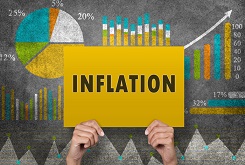U.S.News & World Report: Should Investors Prepare for Stagflation?

Article by Debbie Carlson on U.S. News & World report
Former Federal Reserve Chairman Alan Greenspan has been quoted about concerns the economy is moving into stagflation – where economic growth stalls but inflation continues to rise.
Stagflation was last seen in the 1970s, and brings back memories of high oil prices, high inflation, high unemployment and recession.
Despite the current strength, is the U.S. economy headed to another bought of stagflation? Some market watchers point to higher oil prices – U.S. crude oil futures are up 41 percent from a year ago – and for the first time in six years, the personal consumption expenditures price index, the Federal Reserve’s preferred inflation measure, hit the Fed’s 2 percent target in May.
The missing ingredients are high unemployment and a recession. Currently unemployment is at record lows. The U.S. and global economies are doing well, but some market analysts point to slowing signs such as monetary supplies tightening as the Fed has raised rates.
Inflationary concerns. Jeffrey MacDonald, managing director and head of fixed income strategies at Fiduciary Trust Company International in New York City, says people like Greenspan who are concerned about stagflation point to factors like the economic stimulus produced by last year’s tax cuts and continued deficit spending, which can lead to inflationary pressures. Then there are worries about tariffs and trade wars.
“That cost-push type of inflation would not be good for real economic output because it's not driven by demand,” he says.
There are two types of inflation, MacDonald says. The kind created by aggregate demand as people buy more stuff because they have jobs and the economy is doing well is what he calls “good” inflation. “Bad” inflation is driven by costs going up – such as in the 1970s when oil prices jumped.
“That’s a drag on demand because your input costs are pushing up prices,” he says.
The current rise in inflation is the “good” inflation, he says, and is one of the reasons he doesn’t see stagflation happening. The other two reasons are low unemployment and continued economic growth.
Jay Hatfield, portfolio manager of the InfraCap MLP exchange-traded fund, says while the country’s massive deficits could be an eventual drag on economic growth, he says the changes in the corporate tax structure will be healthy in the short and long-run, which may lead to more sustainable economic growth and fend off stagflation.
“The tax cuts will stimulate more investment, which is sustainable growth because it comes from the investment side,” Hatfield says. “If you try to stimulate consumption, it's an unsustainable growth.”
Ken Moraif, senior advisor at Money Matters in Dallas, a wealth management and investment firm, says inflation could be a significant issue in the future because of the amount of government debt. It’s easier, he says, to pay back that debt by letting inflation rise versus cutting services and raising taxes. But if inflation rises so high that consumers can’t afford to buy anything, that could lead to a recession. While inflation could be an issue in the future, stagflation isn’t a concern right now, he says.
Jim Paulsen, chief investment strategist of The Leuthold Group in Minneapolis, is a little more concerned about the signs pointing to cost-push inflation, such as higher oil prices and the potential for stagflation. He’s concerned inflation and the 10-year U.S. Treasury note both hit 3 percent.
Economic slowing elsewhere. Paulsen has noticed signs of economic slowing in Europe and in emerging markets, particularly in China, and it’s likely to come here. Tighter monetary conditions are being overshadowed by the focus on fiscal stimulus for the tax cut, he says. Yields on the 10-year U.S. Treasury notes have doubled and there’s been a decline in the year-on-year growth rate in the M2 money supply, which includes cash, checking deposits, savings deposits, money market securities, mutual funds and other deposits.
Paulsen says the combination of tightening money supply, rising oil prices and higher commodity costs hitting corporate budgets and margins suggests there's a strong case to be made that the economy will slow. If gross domestic product growth slows, that's going to affect Wall Street's attitudes about earnings, but it might not stop wages and inflation rising. If inflation rises above GDP, “that’s stagflation,” he says.
Stagflation investment options. If stagflation occurs, MacDonald says, corporate earnings would take a hit because slower economic growth would pinch corporate profits. He says “the best places to hide” in a stagflationary environment would be real estate, or commodities like gold; hard assets that are stores of value.
But you want to look at the actual commodities themselves, rather than the stock of commodities producers because of the drag stagflation has on corporate earnings, he says.
“If we have inflation worries or stagflation worries, guess what? Commodities might do pretty well in that environment,” Paulsen says.
To read this article in its entirety on U.S. News & World Report, click here